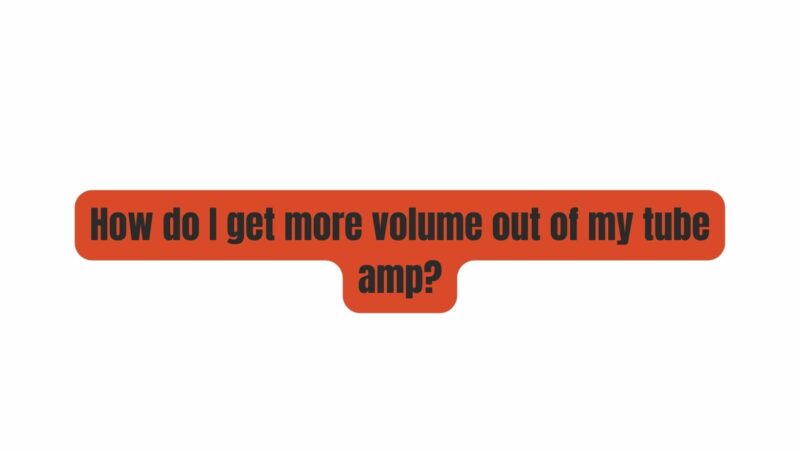Tube amplifiers, also known as valve amplifiers, have a long-standing reputation for their warm, rich, and organic sound. Musicians and audiophiles alike appreciate their unique tonal qualities and classic design. However, one common challenge users face with tube amps is achieving the desired volume level without compromising tone or risking damage to the amplifier. In this article, we will delve into the world of tube amps and explore various techniques to get more volume out of your beloved tube amplifier without sacrificing sound quality or reliability.
I. Understanding Tube Amplifiers
Before we jump into techniques to boost volume, it’s essential to have a basic understanding of how tube amplifiers work. Unlike solid-state amplifiers, which use transistors, tube amps utilize vacuum tubes (or valves) to amplify the audio signal. These tubes have a unique characteristic: as you push them harder, they produce a harmonically rich distortion known as “tube saturation” or “tube overdrive.” This distortion adds warmth and character to your sound, which is often sought after by musicians.
However, achieving higher volume levels on a tube amp can be more complex due to their inherent limitations compared to solid-state counterparts. To navigate these challenges effectively, let’s explore various strategies for maximizing volume:
II. Selecting the Right Tube Amp
- Amplifier Wattage: One of the primary factors affecting volume is the wattage of your tube amp. Generally, higher-wattage amps can produce more volume. However, it’s crucial to balance wattage with your specific needs. A 100-watt amp may be overkill for home practice but ideal for large stages. Consider your playing environment and intended use.
- Amplifier Design: Different tube amp designs produce different volumes. For instance, a combo amp with a single speaker may not deliver the same volume as a head and cabinet setup with multiple speakers. Research various designs and configurations to find the one that suits your volume requirements.
III. Preamp Gain and Volume Controls
- Preamp Gain: The preamp section of your tube amp controls the input signal’s amplification before it reaches the power amp. Increasing the preamp gain will naturally drive the tubes harder, adding distortion and increasing volume. However, be cautious not to overdo it, as excessive gain can lead to undesirable noise and excessive distortion.
- Volume Control: Most tube amps have separate volume controls for both the clean and overdriven channels. Experiment with these controls to balance your clean and distorted tones while maximizing volume. Often, a slight increase in the clean channel’s volume can add perceived loudness without additional distortion.
IV. Tube Selection and Maintenance
- Tube Types: The type of tubes used in your amplifier greatly influences its sound and volume capabilities. Some tubes are known for their higher headroom (ability to handle more volume before breaking up), while others excel at producing natural overdrive. Consult with a knowledgeable technician to choose tubes that suit your volume preferences.
- Tube Maintenance: Tubes wear out over time and can lose their ability to produce optimal volume and tone. Regularly replace tubes to ensure your amp operates at its best. Additionally, having a qualified technician bias your tubes can optimize their performance and extend their lifespan.
V. Speaker Selection and Cabinet Considerations
- Speaker Efficiency: The efficiency of your amplifier’s speaker(s) plays a significant role in overall volume output. More efficient speakers require less power to produce the same volume, allowing you to achieve higher volumes at lower wattage settings.
- Speaker Cabinet Size: The size and construction of your speaker cabinet affect the amp’s projection and dispersion. A larger cabinet with multiple speakers can enhance volume and spread sound more effectively. Experimenting with different cabinet configurations can help you find the perfect balance between volume and tone.
VI. External Effects and Pedals
- Boost Pedals: Consider using boost pedals or overdrive pedals to push your tube amp’s front end. These pedals can provide an additional volume boost while preserving the natural tube-driven tone. Some boost pedals also offer EQ adjustments to fine-tune your sound.
- Effects Loop: If your tube amp has an effects loop, you can place time-based effects (like delay and reverb) in the loop, allowing you to add spaciousness without affecting the amp’s core volume. This can create a perception of greater volume and a more expansive sound.
VII. Sound Engineering Techniques
- Mic Placement: When miking your tube amp for live performances or recording, experiment with microphone placement. Moving the microphone closer to the speaker’s center cone can capture a louder and more focused sound, while positioning it near the edge can yield a mellower tone.
- Sound Isolation: In some situations, using sound isolation or isolation cabinets can help you achieve higher volumes without overpowering the stage or room. These enclosures reduce stage volume while allowing you to crank up your amp for the desired tone.
VIII. Protecting Your Hearing
- Ear Protection: As you explore these volume-boosting techniques, it’s essential to prioritize your hearing health. Long exposure to high volumes can cause hearing damage. Invest in quality ear protection like musician’s earplugs or noise-cancelling headphones to safeguard your hearing while enjoying your tube amp.
Conclusion
Unlocking the full potential of your tube amp to achieve higher volume levels without compromising tone is an art that requires experimentation and a deep understanding of your amplifier’s capabilities. By selecting the right amp, optimizing controls, choosing suitable tubes, and considering external factors like speakers and mic placement, you can enjoy the rich, harmonically pleasing sound of your tube amp at any volume level you desire. Remember to prioritize both your amp’s health and your own hearing while exploring these techniques, ensuring that your musical journey remains enjoyable and sustainable.


